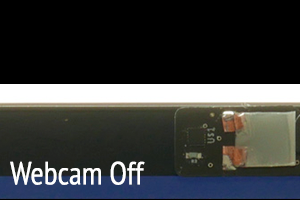|
Recent discourses on smart cities have been primarily focused on the deployment of technical infrastructures such as sensor installation, data collection, and security measures. These practices, however, are accompanied with tacit and explicit ideas about ideal cities and human values. This paper presents the preliminary results of an ethnographic study that looks closely at the North Avenue Smart Corridor in Atlanta, Georgia aimed at unpacking the driving ideas behind smart cities initiatives and critically engaging its key assumptions of progress and efficiency. |
Laptop webcams can be covertly activated by malware and law enforcement agencies. Consequently, 59% percent of Americans manually cover their webcams to avoid being surveilled. However, manual covers are prone to human error–through a survey with 200 users, we found that over 60% occasionally forget to re-attach their cover after using their webcam. To address this problem, we developed Smart Webcam Cover (SWC): a thin film that covers the webcam by default, and automatically uncovers the webcam when its LED indicator is lit.  |
||
|
Smog Solver is an environmental web simulation of how the smog problem can be possibly solved in Beijing. The purpose of this simulation is to educate users about the major causes of smog in Beijing and the solutions through replays. According to the final evaluation, my simulation could effectively help users learn ~92% of the major causes of smog and increase their knowledge of the solutions. |
Text messaging is a functionality that has been widely used in user studies due to its presence in smartphones and feature phones alike. However, the ability to use cell phones for data collection has been limited to researchers that have programming abilities. We present SMSPress, a web-based SMS management system that allows non-technical users to configure SMS studies, and schedule text messages for delivery to participants via a web-interface. We establish the requirements for such a system and present the results from two case studies. |
We are developing technological platforms, human and social processes, and the underlying creative abilities to leverage social media and digital networks to enhance democracies especially in Africa. Our current work has focused on participation in and monitoring of elections while future work will expand that frame seeking to foster broader and deeper civic engagement, especially among youth, the promotion of government accountability and efficacy, and the constructive creative ability to hack democracy.  |
Social Media is changing our world. Traditional narratives paint a picture of many-to-many democratization of information--making ideas, opinions, education, and knowledge available to many people in many places at any time. This research examines whether this is actually the case, especially in countries with a totalitarian government. Through an interview-based study of Cuban participants on social media, this project explores both the limitations and opportunities of cyber networks as tools for individuals to create collaborative narratives and affect social change. |
|
Social Media Interventions for Eating Disorder Communities on Reddit |
Psychosocial Effects of COVID-19 Pandemic |
The Social Sensing study is studying the inclusion of social support in therapy for Veterans with PTSD as a part of the larger Prolonged Exposure Collective Sensing System study led by Dr. Rosa Arriaga from Georgia Tech’s College of Computing and supported by NSF grant 1915504.  |
Social TV is a mobile application that works in conjunction with watching TV. It is targeted to users who may be living in a new location and watch TV alone, or to users who want to increase the social aspect of watching TV. Through integration with Facebook, the mobile app presents a TV Feed where users can share information, such as screenshots, quotes and recommendations with other individuals in their network. The app has a TV chat feature, where users can engage in both synchronous and asynchronous chatting about what is occurring in the show of their choosing. |
|
Can sensor-instrumented toys be used to monitor health and improve enrichment for sea otters at the Georgia Aquarium? This project looks at the design requirements of computer-driven otter enrichment devices and how we can help otter trainers derive meaningful health insights from the data pulled from such devices.  |
Here, we report a wireless, fully integrated, soft sternal patch with mechanics optimized to detect the mechanical, electrical, and optical signals that characterize the cardiovascular response to OSA. Analytical and computational studies in mechanics and material interfaces yielded a fully integrated, multi-sensor system capable of capturing ultrafine, low-frequency, sternal vibrations caused by the heart's motion, cardiac electrical signals, and optical measurements of arterial blood oxygenation from a single location on the sternum, which has not been previously realized.  |


